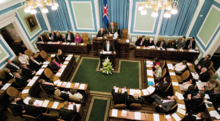
Back ألثينغي Arabic Alþingi AST Altinq Azerbaijani Althing BAR Альтынг Byelorussian Альтынг BE-X-OLD Alþingi Catalan Althing Czech Alþingi Welsh Altinget Danish
Icelandic Parliament Alþingi Íslendinga | |
|---|---|
 | |
| Type | |
| Type | |
| History | |
| Founded |
|
| Leadership | |
| Structure | |
| Seats | 63 |
 | |
Political groups | Government (38)
Opposition (25)
|
| Elections | |
| Open list proportional representation | |
Last election | 25 September 2021 |
Next election | September 2025 |
| Meeting place | |
 | |
| Alþingishúsið, Reykjavík | |
| Website | |
| www | |
 |
|---|
|
|
64°08′48″N 21°56′25″W / 64.14667°N 21.94028°W The Alþingi (pronounced [ˈalˌθiɲcɪ]; Icelandic for 'general meeting'), anglicised as Althingi or Althing, is the supreme national parliament of Iceland. It is one of the oldest surviving parliaments in the world.[1][2][a] The Althing was founded in 930 at Þingvellir ('thing fields' or 'assembly fields'), situated approximately 45 kilometres (28 mi) east of what later became the country's capital, Reykjavík. After Iceland's union with Norway in 1262, the Althing lost its legislative power,[4] which was not restored until 1903 when Iceland gained Home Rule from Denmark. For 641 years, the Althing did not serve as the parliament of Iceland, ultimately power rested with the Norwegian, and subsequently the Danish throne.[4] Even after Iceland's union with Norway in 1262, the Althing still held its sessions at Þingvellir until 1800, when it was discontinued. It was restored in 1844 by royal decree and moved to Reykjavík.[5] The restored unicameral legislature first came together in 1845 and after 1874 operated in two chambers with an additional third chamber taking on a greater role as the decades passed until 1991 when Althing became once again unicameral.[6] The present parliament building, the Alþingishús, was built in 1881, made of hewn Icelandic stone.[7] The unicameral parliament has 63 members, and is elected every four years based on party-list proportional representation.[8] The current speaker of the Althing is Birgir Ármannsson.
The constitution of Iceland provides for six electoral constituencies with the possibility of an increase to seven. The constituency boundaries and the number of seats allocated to each constituency are fixed by legislation. No constituency can be represented by fewer than six seats. Furthermore, each party with more than 5% of the national vote is allocated seats based on its proportion of the national vote in order that the number of members in parliament for each political party should be more or less proportional to its overall electoral support. If the number of voters represented by each member of the Althing in one constituency would be less than half of the comparable ratio in another constituency, the Icelandic National Electoral Commission is tasked with altering the allocation of seats to reduce that difference.[9]
- ^ "A short history of Alþingi – the oldest parliament in the world". europa.eu. The European Union. Archived from the original on 15 November 2017. Retrieved 7 April 2017.
- ^ Meredith, Sam (28 October 2016). "World's oldest parliament poised for radical Pirates to takeover". CNBC. Retrieved 7 April 2017.
- ^ The High Court of Tynwald, The High Court of Tynwald (www.tynwald.org.im), retrieved 14 November 2011
- ^ a b Cite error: The named reference
athwas invoked but never defined (see the help page). - ^ Sigurðardóttir, Heiða María; Emilsson, Páll Emil. "Hvenær var Alþingi stofnað?". visindavefur.is. Vísindavefurinn. Retrieved 7 April 2017.
- ^ "Aldarfjórðungur frá því að deildaskipting var aflögð".
- ^ "ALÞINGISHÚSIÐ – ÁGRIP AF BYGGINGARSÖGU ÞESS". Morgunblaðið. 24 April 1949. Retrieved 7 April 2017.
- ^ Álvarez-Rivera, Manuel. "Election Resources on the Internet: Elections to the Icelandic Althing (Parliament)". electionresources.org. Election Resources. Retrieved 10 April 2017.
- ^ "Stjórnarskipunarlög um breytingu á stjórnarskrá lýðveldisins Íslands, nr. 33/1944, með síðari breytingum". althingi.is. Alþingi Íslands. Retrieved 7 April 2017.
Cite error: There are <ref group=lower-alpha> tags or {{efn}} templates on this page, but the references will not show without a {{reflist|group=lower-alpha}} template or {{notelist}} template (see the help page).